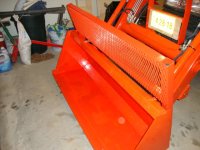I did something very similar allthough I used 2" heavy wall tube for the forks. About 2' long. Works great for lifting the logs.
I Had some angle iron when laid in the corner of the bucket was the perfect inside dimensions for standard 2" tubing. Allthough you could also use actual hitch tubing if you wanted.
I drilled and tapped a hole at the very back of the fork and put a bolt in to keep them from falling out and it doesnt put any stress on a crosspin.
I chose the very corners of the bucket for strength. That way I am not just welded to the bottom lip, but rather the side plate as well. One of the best parts is if you use the 2" tube like this, you can put you reciever inserts in as well for moving trailers. I have also made two short "stub" forks that dont extend beyone the bucket edge. I got tired of digging all the dirt out when I wanted to put the forks on.
And another benifit I found out is, when cutting wood, I can get a log in the air that is about double what I can actually lift. Once under the log, plat the heel of the bucket into the gound and rollback. Most loaders have more breakout/curl force than lift force. By planting the heel, you arent putting any added weight on the front end, and the geometry of the bucket and curl back angle allows you to get a log a good 10" off the ground.


